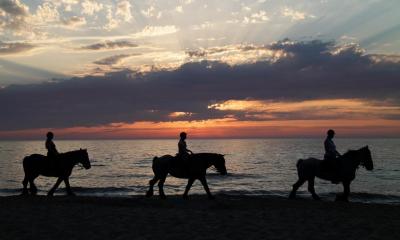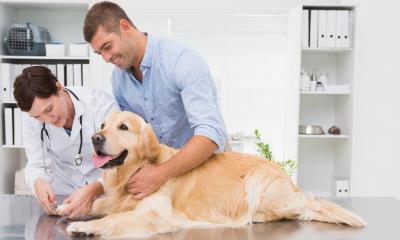
Thinking of offering pony trekking services? You'll need horses and ponies suitable for all standards of rider. Read our in-depth practical guide to starting up and running your own pony trekking centre.
- Research your target market
- Establish your customer profile
- Decide what services to offer
- The trekking centre
- Accommodation
- Seasonality
- Pricing policy
- Buy an existing business
Research your target market
Estimating demand
It's very important to find out whether there is enough demand for a pony trekking centre in your area. Be aware that many farmers have diversified into this type of activity in recent years because of the downturn in farm incomes. As they already own land and may have suitable buildings they are in a strong position to compete with a stand-alone trekking business.
Riding schools may also offer pony trekking so you will need to check out the competition carefully. A browse on Yell.com and other similar online directories under Riding Schools will give you an idea of how many riding centres currently offer trekking in your area and give you an idea of the range of activities and services they offer. You could do an online search for competitors as well as looking at local print directories. You can also find existing riding holiday centres in your area on the British Horse Society (BHS) website.
As well as checking out the competition it is also very important to make sure that there are plenty of places where people can ride. Are there lots of bridleways and opportunities for off-road riding such as moorland, woodland, coastal paths or beaches? Is the surrounding countryside attractive so that it is already a tourist destination? Are there nearby facilities such as pubs, hotels, shops and places of interest so that people coming for a residential riding holiday have plenty to do? You will find your local tourist information authority a helpful source of statistics about the level of tourism in your area.
If possible, visit other riding and trekking centres to find out:
- the range of trekking and other services they offer
- whether they provide accommodation and board, and if so, to what standard
- whether their yards and stables are well laid out and maintained
- whether the horses and ponies are in good condition
- whether the staff are well trained, helpful and polite
- if they're approved by the BHS
Many trekking centres have a website which provides a lot of information about the services they offer and the prices they charge. Visit as many of these websites as possible to get good ideas about the way your business might operate - and also to check out what local competitors are offering.
Why will people choose your trekking centre
It's important to try to make sure that enough people will choose your centre rather than your competitors so that your horses are as fully utilised as possible. Riding is popular with people of all ages and from all backgrounds and is an activity that the whole family can enjoy. This might be your Unique Selling Point (USP) - emphasising that your ponies are well schooled and suitable for all abilities, from complete novice to advanced rider.
Becoming BHS approved will reassure potential customers that you aim to provide them with the highest standards of service and conform to the latest health and safety requirements. You will also be able to reach a wider audience for your business by promoting it through the BHS website and publications including British Horse magazine, which is the UK's highest circulating equestrian magazine.
You might be located near a large centre of population and decide to target young professionals looking for an active day out, or possibly an evening pub ride on a summer's evening. You might consider targeting stag and hen parties and other groups of riders.
Think about the type of rider you will be targeting and then make sure that your mounts, your facilities and the treks you offer all tie-in with this.
Have a close look at your potential customer base - are there any schools nearby who might be interested in sending groups of pupils for an afternoon's riding? What about asking your local GP to put you in touch with your hospital's physiotherapy unit - riding can be an excellent activity for those with a physical disability. Alternatively your centre might become part of the Riding for the Disabled Association (RDA) network of certified members which offers riding activities to people with disabilities throughout the country. Visit the RDA website for details.
Research current trends, plus legal and tax issues
- Sector trends for pony trekking centres
- Legal issues for pony trekking centres
- VAT rules for pony trekking centres
Establish your customer profile
Your market
Your customers are likely to be of all ages and from a variety of backgrounds. Many of them will be novices so it's very important that you have suitable horses and ponies for them to ride.
Customers might be mainly local people or you might also offer longer riding holidays to people from all over the country or even from abroad. You would probably offer these customers board and accommodation - or offer to arrange it for them. Some of your customers might be local groups and parties of pupils or club members. Many riding centres offer riding facilities for disabled people. You might agree to a regular block booking from your local hospital physiotherapy unit.
Don't forget that you will need to provide a competent and experienced trek leader for each group of riders - ideally one escort per six riders. The Horse Rider's Hacking Handbook by Karen Bush is the official manual of the Association of British Riding Schools. The manual contains comprehensive information for ride escorts. You can find out more about the publication on the Crowood Press website.
Special offers and discounts
You might be prepared to have promotional special offers from time to time. For example, you might charge a reduced fee for a mid-week trek, when demand is lower. You could offer group rates to attract larger parties. If you offer camping or self-catering facilities you could offer guests a discount on trekking activities.
Decide what services to offer
It's a good idea to decide at an early stage in your planning what type of trekking you will offer. For example, you might offer some or all of the following:
- one or two hour hacks
- half or full day treks
- weekend or week-long treks
- evening pub rides
- multi-base treks. These consist of day treks to a number of different overnight stops, where accommodation for both horse and rider is provided
Think about whether you'll offer one-to-one hacks as well as rides for small groups. Groups might include stag, hen and birthday parties.
If you intend to offer longer treks and riding holidays you might provide board and accommodation, self-catering accommodation or campsite facilities. Or you might arrange accommodation with local guesthouses, hotels, pubs and B&Bs. Consider what food you will provide if you offer accommodation, for example, you might decide to only provide breakfasts and packed lunches.
There are a number of other services that you could offer your customers, such as:
- hire of riding footwear, clothing and safety riding hats
- transport to and from your local rail or bus station
- outings and excursions for non-riding partners
- riding lessons, including jumping and dressage
You might consider selling gift vouchers - for example a 'book' of ten one-hour hacks or lessons. Some trekking centres sell gift vouchers through their website.
Some trekking centres welcome riders who bring their own horses - a charge is made for the keep of the animal during the holiday.
If space permits, you could consider offering livery services to local horse owners. Arrangements vary but sometimes the centre uses the horse for rides or lessons in return for charging the owner a reduced fee.
The right image
It is very important that your establishment projects the right image. Customers have become increasingly discerning and it is essential that your stables, yard and pastureland are well maintained and smart and that your horses are well groomed and fit. If you offer catering and accommodation this should be to a high standard. If you plan to target groups of young people it is particularly important that you clearly demonstrate that you run a safe operation. It would be worth highlighting any first aid qualifications held by staff to reassure prospective customers.
Advertising your business
Whatever the range of trekking and other services you decide to offer, you must make sure your potential clients know about you. Of course, word of mouth recommendation is one of the best ways of getting customers, but there are a number of things you can do which will promote your business:
- advertise in your local newspaper and any local leisure directories
- if you plan to attract people from all over the country (or abroad) for longer riding or trekking holidays you could provide regional tourist information offices with promotional literature
- gain British Horse Society (BHS) or Association of British Riding Schools (ABRS) approved status to benefit from a listing in their directories
- set up your own website highlighting the quality service you offer. You might incorporate a booking and payment facility into your site
- use social media like Facebook and Twitter to let people know about exciting new treks and special offers
The trekking centre
Your trekking centre premises will need to include:
- stabling. Stables should be well constructed, lit and ventilated. British Horse Society (BHS) standards specify a minimum size of 10ft x 10ft for ponies and 12ft x 12ft for horses
- dry and secure storage for feed, hay and straw. Think about how you will keep rats and mice out of feed stores. You'll also need to make sure thieves don't steal hay and other feed - this has become more of a problem, particularly when there is a series of bad winters
- rug, boot and hard hat storage room
- a muck pile/storage area
- a yard where horses can be washed down and groomed
- toilet facilities for both staff and riders
- grazing. The amount of land you will need will depend on whether it is to provide total grass keep or supplementary grazing. However, BHS guidelines specify between one and one and a half acres per horse for permanent grazing. It is important that field boundaries and gates are safe and secure. Good pasture management is essential
- parking facilities
If you have enough space and resources you might consider providing a floodlight arena and/or an indoor school. This provides an opportunity for people to ride during the winter months when your income from trekking is likely to be low or non-existent.
You might also consider offering overnight accommodation - for example in a converted barn. If you have enough land you could consider offering camping facilities.
Think about becoming a BHS-approved trekking centre. You'll be regularly inspected by the BHS to make sure you meet high standards and then given an appropriate grading - Approved, Commended or Highly Commended. This reassures potential customers about the quality of the horse care you provide and the customer service you offer. You'll benefit from a listing on the BHS website and a link to your own site. The BHS is continuing to develop its approved centre scheme with the aim of securing UKAS accreditation by April 2018 so, when the new animal activities licensing regulations are introduced, BHS approval could mean you can get a lower risk score so you can be granted a longer licence at a lower annual cost.
Accommodation
You might decide to offer longer treks, for example, weekend breaks or week long riding holidays during which you escort groups of riders on day treks in the surrounding countryside.
You can either accommodate these guests yourself or offer to arrange suitable accommodation for them in nearby hotels, guest houses and B&Bs.
If you plan to provide board and accommodation yourself you'll need to give some thought to the type of accommodation this will be. It might consist of bunk house or hostel-type rooms designed with children and young people in mind or you might be planning a much more upmarket venture, with a very high standard of accommodation provided.
Think carefully about any meals you will offer and who will prepare them. If there are plenty of local pubs and restaurants nearby it might be more profitable to just offer breakfast, although if you are targeting, say, teenagers you will probably have to provide full board. This might include providing a packed lunch every day.
If you have sufficient space you might consider setting up a camp or caravan site - this could be used by both riders and non-riders.
You might be interested in offering overnight accommodation to riders who have nothing to do with your trekking business but who are looking for somewhere to stay with their horse. The Horses Welcome Scheme operates throughout the UK, and uses British Horse Society (BHS) personnel to vet the accommodation and to certify it's suitable for horses. The BHS website includes more information about the scheme.
Whatever type of accommodation you decide to offer, don't forget to obtain the appropriate planning consents and to make sure you are aware of all the legislation that you will need to comply with, such as fire and food safety regulations.
Seasonality
It's important to remember that most, if not all, of your trekking income will arise during the late spring, summer and early autumn. Many people do not enjoy going for long rides during the cold winter months, particularly when it is wet, windy or snowy.
The trekking 'season' is a bit longer in the south and west of the UK than in the north and Scotland and you'll need to make a realistic estimate of the number of weeks in the year when you are likely to be busy. Realistically this is likely to amount to between 100 and 120 trekking days per horse per year.
You may be able to offer other services during the off-season winter months which will tide you over, for example, riding lessons or livery services. Bear in mind that you will have to feed and care for your horses even if they are not earning any income. Similarly, you may have to pay staff wages throughout the year, not only because you need staff to look after the animals but also because you won't want to risk losing well qualified and experienced instructors and ride leaders.
Pricing policy
How will you decide on your prices?
The number and type of horses that you have will inevitably affect your earning potential - you will need horses and ponies of different sizes, performance and temperament so that you can cater for riders of all ages and abilities. You will also need to make provision for the quieter months, when trekking income is likely to be low. Bear in mind that you will also need to budget to replace your mounts once they become too old to work.
So you will need to consider:
- how much income you need to earn to cover all of your operating costs, including staff wages and your own drawings
- how many horses and ponies you can accommodate
- how busy you are likely to be
- how many days each year will realistically be suitable for trekking
- the costs you will incur per horse such as bedding, concentrate feeds, hay, veterinary and medicines, tack purchase and repair, shoeing, grazing costs and so on. (The British Horse Society - BHS - produces a guide to the cost of keeping a horse or pony, which might be helpful. You can download The Cost of Keeping a Horse or Pony from the BHS website)
- any other sources of income such as self-catering or residential accommodation
This will help you to come up with a tariff for the different types of trek or ride you offer. Although this must be based on an appraisal of your own costs, you will need to make sure your charges are broadly in line with your competitors. Many trekking centres post their prices on their website - have a look at a few to see what other centres are charging.
Think about whether you'll offer discounts to people booking a certain number of hacks or lessons in advance, or for off-peak bookings. If you offer one-to-one hacks or lessons make sure you charge enough for these.
Buy an existing business
You might decide to buy an existing pony trekking centre rather than start your own venture from scratch. Buying a going concern can mean that the customers, regular sales, staff, premises, horses and equipment are already in place.
Other matters to consider include:
- the age and condition of the horses and ponies - you might consider asking a vet to look them over
- the quality of the land - will you be able to accommodate a sufficient number of animals without the pasture deteriorating, leading to higher feed bills
But buying a business can be a hazardous, expensive process unless you have the right skills and experience on your team, including legal and financial know-how. Establish the genuine trading and financial position, so that the price you pay for the business is not too high.


